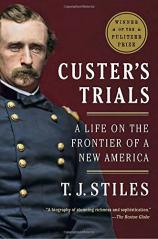Custer's Trials: A Life on the Frontier of a New America
Review
Custer's Trials: A Life on the Frontier of a New America
The comedian Dick Gregory once pointed out, “We used to root for the Indians against the cavalry, because we didn't think it was fair in the history books that when the cavalry won it was a great victory, and when the Indians won it was a massacre.” George Armstrong Custer and the Seventh Cavalry were our nation’s most noteworthy example of Gregory’s observation. In late June 1876, five of the 12 companies of Custer’s total forces were destroyed on the battlefield commemorated as Little Bighorn. The combined forces of the Cheyenne, Lakota and Arapaho nations killed 288 soldiers during the battle, including Custer, two of his brothers, a brother-in-law and a nephew.
To this day, a great debate continues regarding Custer’s place in history. Initial reaction to the tragic news was that the Seventh Cavalry fought a noble battle against overwhelming enemy numbers. Later, Custer would be viewed as an egotistical and reckless military commander who wanted a victory over the Indian nations as a springboard to political and financial success. Custer has been portrayed as a hero on horseback or a bumbling buffoon. He has been the subject of numerous biographies, many of which are quite good. Those works are consistent only in their inconsistent conclusions of who and what Custer was.
"Custer was a complex man who lived in interesting times. Stiles places his life in that context and helps complete the canvas of the portrait of his life painted by many other historians."
T.J. Stiles, an accomplished historian with both a Pulitzer Prize and a National Book Award on his resume, has undertaken the task of adding to the bookshelf of Custer biographies. CUSTER’S TRIALS is his attempt to place the General in the historical context of post-Civil War America, where the western frontier was a far different battleground than previous military campaigns and military men were forced to learn new strategies and tactics. Understanding Custer requires that one understand the times in which he lived and how the era shaped him, not only as a military leader but also as a citizen.
Stiles spends a significant portion of the book on Custer’s career as a cavalry officer in the Civil War; in that conflict, the young soldier won national attention for his bravery and skill. How do we reconcile his military success with his devastating defeat a dozen years after the Civil War? The post-Civil War era was also marked by the industrialization of America and the change from an agrarian economy. Custer remained a military man because he was unable to adjust to the new financial world emerging at the end of the 19th century. Interestingly, Stiles also notes that the era included the growing movement towards women’s independence. Custer’s wife Libby, an intelligent and educated woman, was the embodiment of that movement, and her biography is Custer’s as well. She played a critical role in his career, and she, more than anyone, perpetuated the post-Little Bighorn myth of Custer as a hero.
Inevitably, the Custer life must turn to the Battle of the Little Bighorn. CUSTER’S TRIALS devotes only a brief epilogue to the battle, and the discussion centers on the testimony and evidence presented at a Court of Inquiry. Stiles accepts the conclusion of the inquiry panel that Custer failed to account for the overwhelming numerical superiority of the enemy and, as a result, divided his attacking force, making communication between his units impossible. Had he kept his troops together, the resulting battle might have been different. Buoyed perhaps by their numerical superiority against Custer’s divided units, the Indian nations fought with great skill and courage. Of course, their victory only strengthened American resolve, and this victorious battle would be their eventual undoing.
The verdict on CUSTER’S TRIALS requires an explanation. If you want to read a book about General Custer and the Battle of the Little Bighorn, this should not be your selection. Stiles lists many books in his prologue that are a better introduction to Custer than this one. But if you have read several Custer biographies, then this is the book for you. Custer was a complex man who lived in interesting times. Stiles places his life in that context and helps complete the canvas of the portrait of his life painted by many other historians.
Reviewed by Stuart Shiffman on October 30, 2015
Custer's Trials: A Life on the Frontier of a New America
- Publication Date: October 25, 2016
- Genres: Biography, History, Nonfiction
- Paperback: 640 pages
- Publisher: Vintage
- ISBN-10: 0307475948
- ISBN-13: 9780307475947





